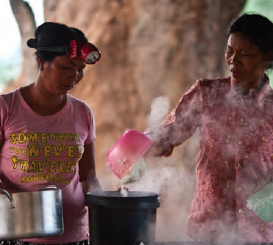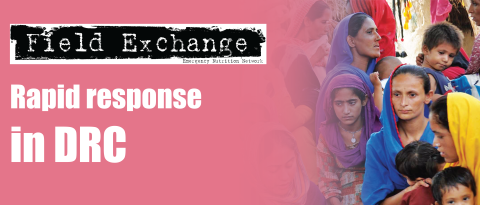Research Snapshots
The following provides a short summary of each of these important research studies. A fuller summary of each can be found online at www.ennonline.net/fex
Inpatient management of children with severe acute malnutrition: a review of WHO guidelines
WHO guidelines for the management of complicated severe acute malnutrition (SAM) advise that SAM case fatality should be less than 10%; in reality, observed mortality rates may be higher, even in well-resourced settings. The purpose of this review was to trace the lineage of each existing recommendation and its supporting citations to identify evidence gaps in the WHO SAM inpatient guidelines that, if filled, may help to further reduce case fatality rates.
Results of the study show that gaps persist and extend across the entire spectrum of treatment of complicated SAM. The evidence base is heavily reliant on expert opinion in the absence of published data, varying by clinical area, and is generally of “very low quality”. Relevant recommendations have undergone very limited substantive revision over the past two or more decades; historical evidence may not be generalisable to contemporary children with complicated SAM. The paucity of relevant research may arise from a misconception that further work is unnecessary because adequate guidelines exist. However, the underlying evidence for most management areas is weak.
The current global undernutrition research agenda is largely focused on reducing the burden of stunting and moderate acute malnutrition, which are important and justifiable areas of concern, but the half a million children who die from SAM annually should not be neglected. Only a few ongoing clinical trials are being conducted in high-priority areas such as antimicrobials use, treatment of HIV-infected children and treatment of infants under six months. Although enhanced implementation of current guidelines would improve outcomes, a renewed and even modest investment in relevant epidemiological and clinical research is likely to lead to more effective recommendations and lower mortality.
Tickell KD and Denno DM, 2016. Inpatient management of children with severe acute malnutrition: a review of WHO guidelines. Bull World Health Organ 2016;94:642–651. doi: dx.doi.org/10.2471/BLT.15.162867
Environmental enteric dysfunction and growth failure/stunting in global child health
Approximately 25% of the world’s children aged under five years have stunted growth, which is associated with increased mortality, cognitive dysfunction and loss of productivity. Environmental enteric dysfunction (EED) may play a central role in the pathogenesis of stunting. This article summarises a three-day meeting organised by the International Atomic Energy Agency (IAEA), which focused on EED and the prospects for its reduction or amelioration in children living in the developing world. The result is a ‘state-of-the-art consensus statement’ on the link between EED and stunting in global child health, which includes the following points.
EED may operate differently in different children; there may be considerable individual variation in gut “leakiness”, bacterial translocation, malabsorption and nutrient requirements. Current understanding of EED is severely limited by its complex spectrum and by the absence of robust biomarkers and non-invasive, simple point-of-care diagnostic tools. Much has been learned about the biology of health and disease states through application of ‘-omics’ technologies:1 genomics, epigenomics, transcriptomics, proteomics and metabolomics. As a pathologic condition, EED is an excellent candidate for -omics surveys because so little is known about the mechanisms through which it exerts its deleterious effects.
In the context of poor socioeconomic conditions, potential interventions to tackle EED include increased access to clean water and improved sanitation and hygiene; promotion of dietary diversity and breastfeeding; adequate supplementation with micro and macronutrients; use of anti-inflammatory agents; and antibiotics for children with severe acute malnutrition and infection. Some research is underway, however, the development of simple point-of-care diagnostic tools and longitudinal studies on EED treatment remain key gaps. Application of innovative technologies and techniques, such as -omics technologies, are needed to better understand, prevent and treat EED.
Owino V, Ahmed T, Freemark M, et al. Environmental Enteric Dysfunction and Growth Failure/Stunting in Global Child Health. Pediatrics. 2016;138(6):e20160641
Feeding behaviours during home-based MAM treatment using corn soy blends or lipid-based nutrient supplements
Community-based care using lipid-based supplements (LNS) or enhanced versions of corn-soy blends (CSB) has been recommended since 2007 for the management of acute malnutrition. LNS and CSB differ in nutritional composition and in texture, usage, preparation and ingestion. Such factors may affect feeding behaviours and are important, given the crucial role of the caretaker and home environment in the community-based care approach. This randomised controlled trial used a qualitative, mixed-methods approach to compare feeding behaviours related to supplementary feeding with a CSB products and LNS in moderately malnourished children. Product-specific feeding advice was provided. Observed frequency of feeding was 1.6 times/day for CSB and 1.5 times/day for LNS; both were mainly eaten as single items, although LNS were mostly likely to be mixed with other foods.
Results show that the main differences in feeding behaviours between the two diet groups were linked to how and when supplements were served. LNS were more likely to be mixed into other foods and fed using an encouraging feeding style with more tactile feeding behaviours. CSB were more likely to be served as a meal and fed using a forced-feeding style. The authors suggest that the difference in feeding styles could be that CSB porridge looks more like a traditional food that caretakers may be used to force-feeding. In contrast, with LNS, caretakers were more aware that they were feeding something different with special instructions to avoid force, emphasised by the fact that LNS were often referred to by caretakers as “medicine”. One surprising finding was the consumption of unprepared CSB flour as a snack. The recommended five-to-ten-minute cooking time for CSB is essential in ensuring digestibility and nutrient availability, which may be affected if consumed without preparation.
The authors summarise that feeding behaviours in relation to supplementary feeding are an important consideration in ensuring successful outcomes of nutritional interventions. Educational instructions should be adapted according to the supplement provided. In particular, efforts should be made to promote an encouraging feeding style with CSB and to ensure preparations are made according to recommendations.
Iuel-Brockdorf A-S, Ouedraogo A, Ritz C, Draebel TA, Ashorn P, Filteau S and Michaelsen KF. (2016) Feeding behaviors during home-based treatment of moderate acute malnutrition using corn-soy blends or lipid-based nutrient supplements. Matern Child Nutr, doi: 10.1111/mcn.12399.
Trial of fish-shaped iron ingot to treat iron deficiency anaemia in Cambodia
 Iron deficiency anaemia (IDA) is a public health problem affecting two billion people (mainly women, children and infants) worldwide, with serious consequences for human health and socio-economic development. Mild to moderate anaemia reduces immunity, work capacity and cognitive ability; severe anaemia is a major cause of maternal morbidity. In Cambodia, the condition affects 55% of children, 50% of pregnant women, and 43% of women of reproductive age. This recent randomized controlled trial (RCT) in rural Cambodia investigated whether cooking with an iron ingot increases haemoglobin and serum ferritin in women, and whether women would use the fish-shaped ingot (resembling a fish considered lucky in Cambodia).
Iron deficiency anaemia (IDA) is a public health problem affecting two billion people (mainly women, children and infants) worldwide, with serious consequences for human health and socio-economic development. Mild to moderate anaemia reduces immunity, work capacity and cognitive ability; severe anaemia is a major cause of maternal morbidity. In Cambodia, the condition affects 55% of children, 50% of pregnant women, and 43% of women of reproductive age. This recent randomized controlled trial (RCT) in rural Cambodia investigated whether cooking with an iron ingot increases haemoglobin and serum ferritin in women, and whether women would use the fish-shaped ingot (resembling a fish considered lucky in Cambodia).
The one year trial found a 46% reduction in the prevalence of anaemia within the intervention group with or without education sessions; women in the control group were more than 2.8 times more likely to be iron deficient and more than 4.6 times more likely to have IDA. The authors noted some initial reluctance to use the ingot, but this was overcome by habitual use in daily cooking routines. Over 90% of women in both intervention groups used the ingot at least three times per week throughout the study. The results imply that regular use of a fish-shaped ingot supplies bioavailable iron that is effective in reducing the prevalence of iron deficiency. Women using the ingot showed improved iron status with or without education sessions, an unexpected outcome for researchers who anticipated that education would make a difference to the impact.
Charles CV, Dewey CE, Hall A, Hak C, Channary S, et al. (2015). A Randomized Control Trial Using a Fish-Shaped Iron Ingot for the Amelioration of Iron Deficiency Anemia in Rural Cambodian Women. Trop Med Surg 3: 195. doi:10.4172/2329-9088.1000195
Weight gain and height growth during infancy, childhood and adolescence as predictors of adult cardiovascular risk
Cardiovascular disease (CVD) is the leading cause of death globally and the population incidence of CVD and related metabolic disorders is higher in low and middle-income countries (LMICs) than in the rest of the world. Mortality because of premature CVD is increasing in South Asian countries such as India. Growth patterns in early life are important predictors of adult CVD risk factors. The purpose of this study was to investigate independent relationships of childhood linear growth (height gain) and relative weight gain to adult CVD risk traits in Asian Indians with the purpose of better understanding this area.
Data was analysed from 2,218 members of the Vellore Birth Cohort at a median 28.1 years of age in Tamil Nadu, India. Cross-sectional height, body mass index (BMI) and longitudinal growth from birth through to adulthood were examined for associations with adult waist circumference, blood pressure, insulin resistance and cholesterol concentrations. Results of the study show that greater height and BMI after birth and through to adolescence are associated with higher CVD risk factors in adulthood and these associations are largely attributable to adult height and BMI.
Monitoring childhood weight and height and active intervention to prevent or reverse upward crossing of BMI percentiles may reduce later CVD risk. In this study, individuals who had greater linear growth during childhood and/or became taller as adults had higher adult waist circumference (WC), blood pressure (BP), insulin resistance and cholesterol concentrations. It is not clear whether these associations reflect an increased risk of future CVD; associations between linear growth and adult CVD risk need further investigation. Infant weight gain was positively related to adult WC, but unrelated to BP or the biochemical CVD risk markers, suggesting that the common clinical practice in LMICs of promoting infant weight gain to enhance survival and neurodevelopment is unlikely to have either adverse or beneficial implications for future CVD risk.
Antonisamy B, Vasan SK, Geethaniali FS, Gowri M, Hepsy YS et al. (2017) Weight gain and height growth during infancy, childhood, and adolescence as predictors of adult cardiovascular risk. Journal of Paediatrics. Vol. 180, p.53-61.e.3.
Maternal Malaria and Malnutrition (M3) initiative
 It is estimated that each year over 125 million pregnant women in low and middle-income countries (LMICs) are at risk of infection with malaria. Malaria contributes to the high burden of maternal morbidity and mortality in these settings and may affect placental development and foetal growth. Sequestration of P. falciparum parasites in the placenta has been associated with foetal growth restriction (FGR) and low birth weight (LBW< 2500g), thus contributing to infant mortality and possibly long-term health problems. Malaria during pregnancy may also cause maternal anaemia, which itself can have deleterious effects on foetal development. It is currently unclear whether the susceptibility to and the impact of malarial infection are affected by maternal nutritional status.
It is estimated that each year over 125 million pregnant women in low and middle-income countries (LMICs) are at risk of infection with malaria. Malaria contributes to the high burden of maternal morbidity and mortality in these settings and may affect placental development and foetal growth. Sequestration of P. falciparum parasites in the placenta has been associated with foetal growth restriction (FGR) and low birth weight (LBW< 2500g), thus contributing to infant mortality and possibly long-term health problems. Malaria during pregnancy may also cause maternal anaemia, which itself can have deleterious effects on foetal development. It is currently unclear whether the susceptibility to and the impact of malarial infection are affected by maternal nutritional status.
A number of studies on malaria in pregnancy have collected maternal anthropometrics and data on anaemia. Similarly, some recent trials of nutritional supplementation during pregnancy collected malariometric indices. The Maternal Malaria and Malnutrition (M3) initiative has pooled data from 13 such studies in Africa and the Western Pacific (14,635 live pregnancies) with the hope of improving the understanding of malaria-nutrition interactions and to foster collaboration between nutritionists and malariologists. Topics of interest for M3 include an evaluation of whether macronutrient undernutrition modifies the impact of malaria infection during pregnancy; the investigation of potential interventions that address both malaria risk and nutritional status during pregnancy; and the study of the role of anaemia in relation to adverse pregnancy outcomes.
Preliminary data from the Democratic Republic of the Congo identified the risk of foetal growth retardation (FGR) was two to eight times higher among women with evidence of malnutrition. Two participating studies provided evidence regarding nutritional interventions during pregnancy (involving fortified food supplementation and lipid-based nutrient supplements). Considerable further analyses are planned. As the largest pregnancy dataset to date, M3 hopes to help identify pregnant women at high risk of adverse outcomes who may benefit from tailored, intensive, antenatal care.
Unger HW, Cates JE, Gutman J, et al. (2016). Maternal Malaria and Malnutrition (M3) initiative, a pooled birth cohort of 13 pregnancy studies in Africa and the Western Pacific. BMJ Open 2016;6:e012697. doi:10.1136/bmjopen-2016- 012697
What’s in a name? A call to reframe non-communicable diseases
In this latest issue of the Lancet, Allen and Feigl comment on the need to reclassify non-communicable diseases (NCDs) in the global health community. The authors state that the historic classification of NCDs provides a name that is defined by what this group of diseases is not, when in fact they now constitute the world’s largest killer (WHO, 2011). NCDs – which include cancer, diabetes, chronic obstructive pulmonary disease, cardiovascular disease and mental health conditions – are the leading cause of death worldwide and disproportionately afflict developing countries. They will cost the global economy US$47 trillion over the next two decades and they continue to push millions of people into poverty (Bloom et al, 2011). Nevertheless, NCDs receive the lowest overseas development assistance per disability-adjusted life-year and even the most cost-effective NCD interventions are severely underfunded compared with their infectious disease counterparts. NCDs are also under-represented in developing countries’ national health plans, undermining progress towards reaching universal health coverage and improvement of human capital.
The authors argue that the current situation might be partly attributable to the framing of these conditions. After all, “anything that begins with ‘non’ may be considered a ‘non-issue’ or a ‘non-starter’” (Sridhar, Morrison and Piot, 2011). Emphasis on individual healthy choices does not account for the growing evidence that some NCDs are partly or wholly communicable and have societal causes, too. The term “non-communicable” does not spur a sense of urgency and deflects attention from effective, system-wide interventions.
The Sustainable Development Goals (SDGs) have cemented the importance of NCDs on the international agenda and appropriate indicators for Goal 3 are being determined. Reframing the issue may help refocus the global response. Although there is no perfect alternative, the authors favour the terms “societal” and “ecological” (i.e. the relation of living organisms to one another and to their physical surroundings), but invite debate on the topic under the auspices of The Lancet Global Health.
Allen LN and Feigl AB. (2017). What’s in a name? A call to reframe non-communicable diseases. The Lancet. Volume 5, No. 2. e129-e130, February 2017.
Hinari Access to Research for Health Programme provides free or very low cost online access to the major journals in biomedical and related social sciences to local, not-for-profit institutions in developing countries. Eligible categories of institutions are: national universities, professional schools (medicine, nursing, pharmacy, public health, dentistry), research institutes, teaching hospitals and healthcare centres, government offices, national medical libraries and local non-governmental organisations. All staff members and students are entitled to access the information resources. For more information, visit: www.who.int/hinari/about/en/
Footnotes
1Collective technologies used to explore the roles, relationships and actions of the various types of molecules that make up the cells of an organism.


